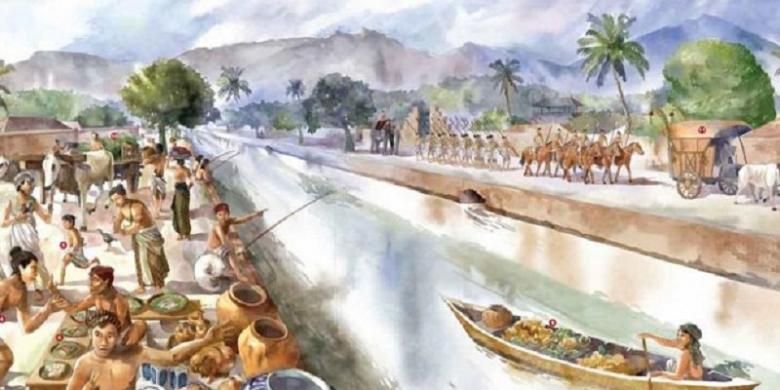Mataram was a Hindu-Buddhist Javanese kingdom based in Central Java between the 8th and 10th centuries AD and was established by king Sanjaya, he was also known as the founder of Sanjaya dynasty. The Sanjaya dynasty reign the kingdom, but then in later period the kingdom was ruled by Isyana Dynasty. Although initially eclipsed in power by the rival SailendraDynasty, by 850 it had become the dominant power in Java and was a serious rival to the hegemonic Srivijaya Empire.
Origin and formation
The early account of Mataram kingdom is mentioned in Canggal inscription, dated 732, discovered in Canggal village, southwest from the town of
Magelang. This inscription was written in
Pallava letters and in
Sanskrit, and tell about the erection of a
lingga (symbol of
Shiva) on the hill in the Kunjarakunja area. This area is located at a noble island called Yawadwipa (
Java) which blessed with abundance of rice and gold. This inscription tells that Yawadwipa was reigned by king
Sanna, which his long period of reign was marked with wisdom and virtue. After king Sanna died the kingdom fell into disunity. Confused because lost of ruler and patron,
Sanjaya ascend to throne, he was the son of Sannaha (sister of Sanna). He was king that mastered holy scriptures,
martial art, and also military prowess. He conquered neighboring area around his kingdom, his wise reign blessed his land with peace and prosperity for all his subjects
[1].

Earliest evidence of a
currencysystem in Java. Javanese
goldmas or tahil ingot, circa 9th century.
From the time of its founding in early 8th century until 928, the kingdom was ruled by the
Sanjaya Dynasty. The first king of Mataram was
Sanjaya, who left the written records on Canggal inscriptions. However around mid 8th century,
Sailendra dynasty emerged in Central Java and challenged Sanjaya dynasty domination on the region. According to Kalasan inscription dated 778 AD, pranagari script written in
sanskrit, the
Kalasan temple was erected by the will of
Guru Sang Raja Sailendravamçatilaka (the Jewel of
Sailendra family) that succeed to persuade
Maharaja Tejapurnapana Panangkaran(Sanjaya's successor) to construct a holy building for the goddess (boddhisattvadevi)
Tara and also build a
vihara(
monastery) for Buddhist monks from Sailendra family's realm. Panangkaran awarded the Kalaça village to
sangha (Buddhist monastic community).
[2].
The received version holds that the Sailendra dynasty existed next to the Sanjaya dynasty in Central Java, and much of the period was characterized by peaceful co-existence and cooperation. A theory proposed that Sailendra is a branch of Sanjaya family that convert to Buddhism. Another theory holds that Sailendra with their strong connections to
Srivijaya managed to gain control on Central Java and imposing overlordship on the Rakai (local Javanese lords) including the Sanjayas, thus make the kings of Mataram Sanjaya as their
vassal.
Little is known about the kingdom due to the dominance of the Sailendra which during this period construct
BorobudurBuddhist monument.
Samaratungga, the monarch of Sailendra, tried to secure Sailendra's position in Java, cementing alliance with Sanjayas by arranging the marriage of his daughter Pramodhawardhani with Rakai Pikatan.
Around the middle of the 9th century relations between Sanjaya and Sailendra had deteriorated. In 852 the Sanjaya ruler Pikatan had defeated
Balaputra, the offspring of the Sailendra monarch Samaratunga, and princess Tara. This ended the Sailendra presence in Java and Balaputra retreated to the Srivijaya in Sumatra, where he became the paramount ruler.
[
 Spinning jenny
Spinning jenny














